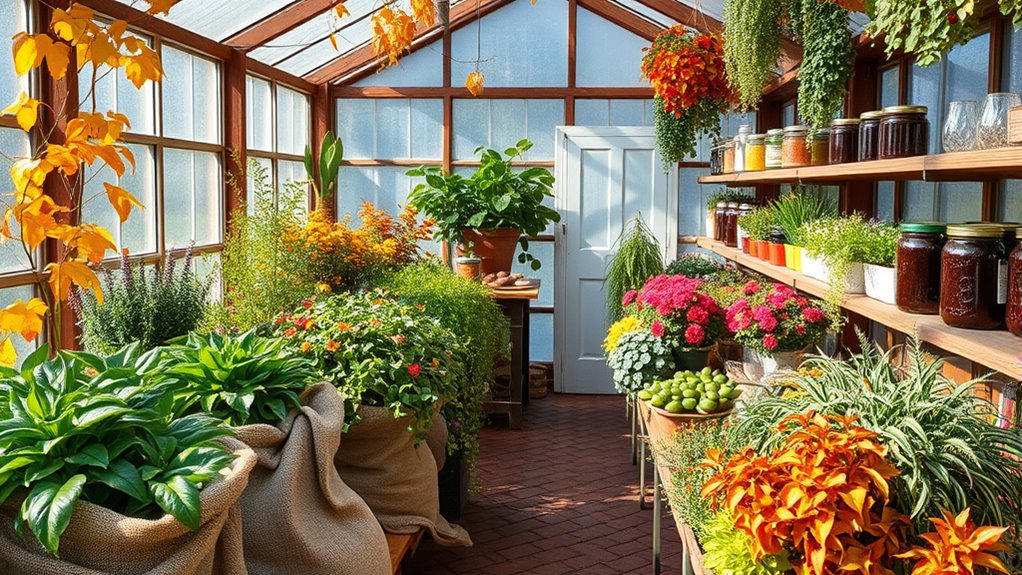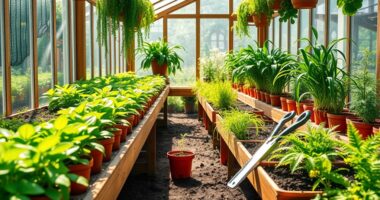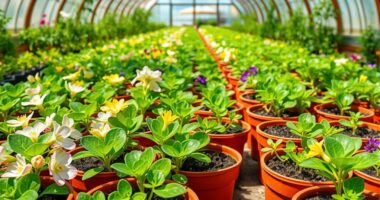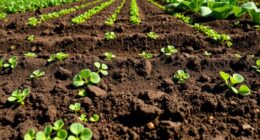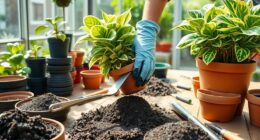To prepare your greenhouse for winter, start by inspecting the structure for any damage and tightening bolts for stability. Ensure your heating and humidity systems are efficient and promote good air circulation. Disconnect and drain your irrigation system to prevent freezing. Select hardy plants and consider adding insulation methods like bubble wrap on panels. Don't forget to seal gaps to retain warmth. Discover more tips to help your greenhouse thrive this winter!
Key Takeaways
- Inspect and repair the greenhouse structure, focusing on frame integrity, glazing, and insulation to prevent heat loss during winter.
- Manage environmental controls by optimizing heating, humidity, and ventilation systems to maintain ideal growing conditions.
- Prepare the irrigation system by disconnecting hoses, insulating fittings, and ensuring all water is expelled to prevent freezing.
- Select winter-friendly plants like cool-season crops and hardy herbs, and disinfect the greenhouse before introducing new plants.
- Enhance insulation by applying bubble wrap, sealing gaps, and using thermal mass techniques to retain warmth throughout the winter months.
Inspecting and Maintaining the Greenhouse Structure
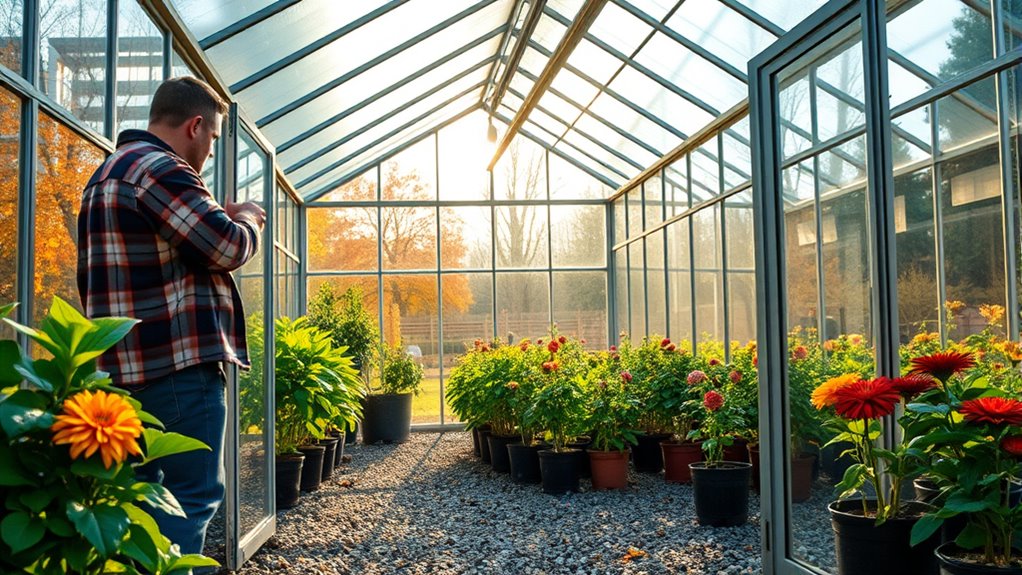
As you transition your greenhouse for fall, it's crucial to inspect and maintain its structure to ensure it stands strong against the elements.
Start by checking the frame for signs of deterioration or damage; make sure all components are secure. Tighten collar ties and truss bolts to maintain structural integrity, especially if windy conditions are expected. Inspect diagonal bracing for tightness to prevent racking. Regularly examine glazing and polycarbonate panels for cracks or gaps, repairing them promptly to avoid heat loss. Clean the panels with mild detergent to maximize light transmission. Additionally, inspect plumbing for drainage to prevent any leaks that could compromise the greenhouse's stability. Finally, ensure that all clips and bar caps are secure for panel integrity and replace any damaged components immediately for stability throughout the winter months.
Ensuring Effective Environmental Control Systems

To create a thriving environment for your plants during the fall and winter months, ensuring effective environmental control systems in your greenhouse is essential.
Start by managing temperature with reliable heating systems, like electric or gas heaters, and use thermostats to prevent unnecessary energy costs. Fully automated systems offer remote programming options that can enhance your ability to maintain optimal temperatures.
Maintain ideal humidity levels between 70-80% with humidifiers or dehumidification technology, and enhance air circulation through proper ventilation.
Optimize lighting by cleaning panels for natural light and employing automated systems for supplemental lighting.
Implement a central command center to coordinate your greenhouse systems, utilizing sensors to monitor conditions.
This automation not only saves time and labor but also enhances energy efficiency, reducing costs while improving crop quality.
Maintaining the Irrigation System
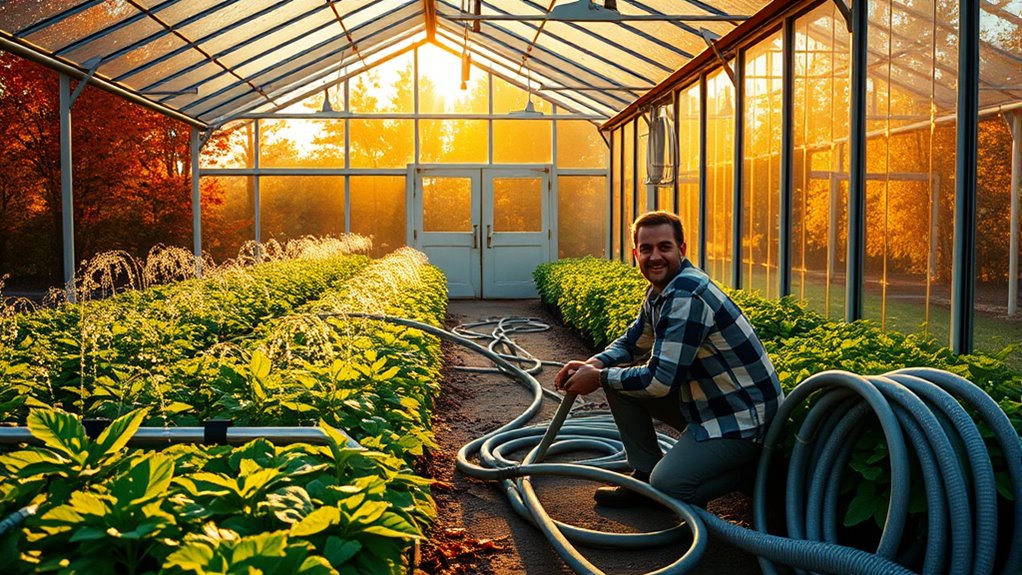
Maintaining your irrigation system during the fall and winter months is crucial for protecting your investment and ensuring a smooth transition into spring. Start by disconnecting all hoses from water sources to prevent freezing and damage. Insulate hose bibs with insulators and completely drain the system to avoid water freezing in the pipes. Additionally, consider using compressed air to blow out the lines as an effective method for ensuring all water is expelled. Remove components like timers and filters, storing them indoors for protection. Inspect the system for leaks or damage, checking filters and valves for wear. Use compressed air to blow out water from the lines and seal open ends with caps. Lastly, elevate fittings slightly to ensure complete drainage. This proactive approach safeguards your system and landscape investments for the upcoming spring season.
Selecting and Caring for Plants
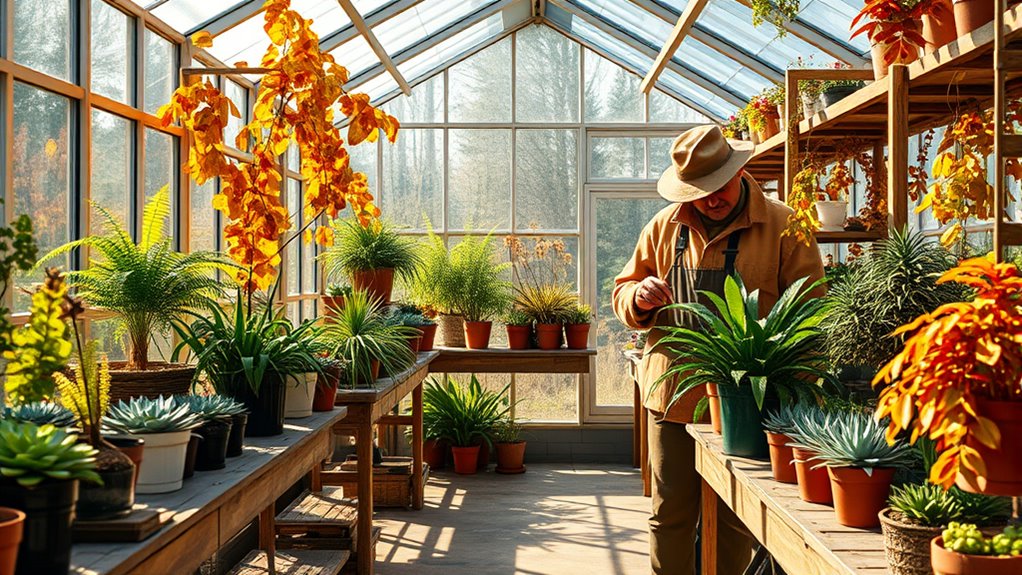
While selecting the right plants for your fall and winter greenhouse, consider their hardiness and growth requirements to ensure a successful transition. Cool-season crops like broccoli, kale, and spinach thrive in cooler temperatures, while semi-hardy crops such as beets, carrots, and lettuce can handle light frosts. Don't forget hardy herbs like chives, thyme, and parsley for winter harvesting, and consider flowers like snapdragons and primrose for added color. For tender perennials like begonias, provide frost protection. Disinfecting your greenhouse is also crucial to create a pest-free environment before introducing new plants. Start seedlings early and expose them gradually to cooler temperatures to prevent shock. Keep an eye on watering needs, prune regularly, and adjust fertilization as growth slows to maintain healthy, thriving plants throughout the winter months.
Enhancing Insulation and Heat Retention
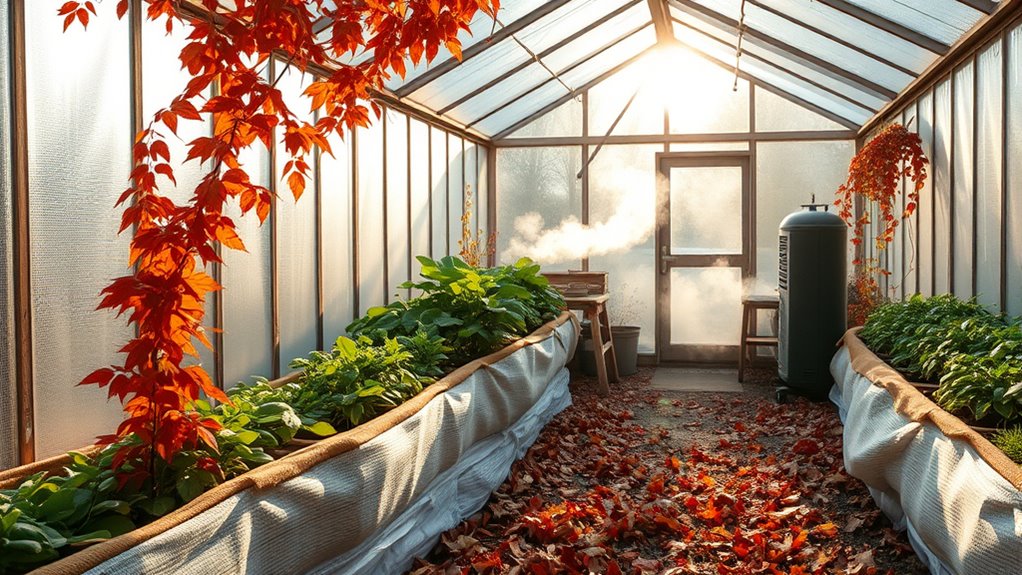
As temperatures drop during the fall and winter months, enhancing insulation and heat retention in your greenhouse becomes essential for keeping your plants thriving.
Start by applying bubble wrap to your glass panels; it acts like double glazing, trapping warm air. For single-glass structures, consider Reflectix insulation to minimize heat loss while amplifying light. Implementing thermal mass techniques, such as using water barrels or rocks, can significantly help absorb heat during the day and release it at night. Seal any gaps with silicone caulk and weather stripping to prevent drafts.
Finally, adding straw bales around the exterior not only insulates but can be reused in spring.
Frequently Asked Questions
How Do I Prepare My Greenhouse for Extreme Winter Temperatures?
To prepare your greenhouse for extreme winter temperatures, start by cleaning and disinfecting the structure and equipment to eliminate any pests.
Inspect and repair any damage to prevent heat loss. Use insulation materials, like foam boards, to minimize heat escape and install thermal curtains.
Check your heating system for efficiency, and consider a backup heater.
Finally, choose cold-hardy plants and supplement light with LED grow lights to ensure healthy growth during the colder months.
What Pests Might Invade My Greenhouse During Winter?
Think of your greenhouse as a cozy winter cabin; however, unwelcome guests like aphids, whiteflies, and fungus gnats might try to crash the party.
These pests thrive in the humid environment you create for your plants. To keep them at bay, regularly inspect your plants, maintain cleanliness, and control moisture levels.
Implementing biological controls and using organic insecticides can help protect your green haven from these pesky intruders during the colder months.
How Can I Prevent Mold Growth in Winter?
To prevent mold growth in winter, keep humidity levels below 60% by using dehumidifiers and improving air circulation with fans.
Ensure proper ventilation and monitor humidity regularly with hygrometers. Avoid overwatering and clean surfaces to eliminate moisture buildup.
Prune plants for better airflow and maintain adequate spacing between them.
Lastly, repair leaks promptly and implement effective drainage systems to manage excess water, creating an environment that discourages mold development.
Are There Specific Winter Crops That Can Thrive in a Greenhouse?
Imagine stepping into a vibrant winter wonderland of fresh greens!
You can absolutely grow specific crops in your greenhouse during winter. Leafy greens like kale and spinach thrive in the cold, along with hardy brassicas like broccoli and cabbage.
Root vegetables such as carrots and beets can endure frost, while alliums like garlic and onions flourish too.
With the right care, your winter greenhouse can be a haven for delicious, fresh produce all season long!
What Are the Signs of Inadequate Ventilation in Winter?
In winter, signs of inadequate ventilation include slow plant growth, yellowing leaves, and increased disease symptoms.
You might notice high humidity levels, causing condensation that can harm your plants.
If temperature fluctuations occur, it can lead to leggy plants and reduced photosynthesis.
Keep an eye out for mold or stale air, as these indicate poor air circulation.
Regularly check your greenhouse environment to ensure your plants thrive during the colder months.
Conclusion
As you transition your greenhouse for winter, remember that a little preparation goes a long way. By inspecting your structure, maintaining environmental controls, and selecting the right plants, you're not just protecting your investment—you're nurturing life. Think of your greenhouse as a cozy sanctuary, a refuge where growth continues even in the cold. With these steps, you'll create an environment that thrives, proving that with care, winter can be just as fruitful as summer.
